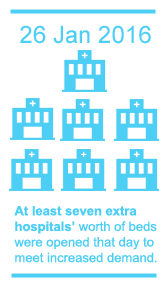In a new short series, the Nuffield Trust is looking closely at some of the big issues behind pressure on the NHS in winter months. Here, Chief Economist Prof John Appleby presents the findings of a new analysis of bed occupancy levels from NHS England situation reports for last winter. The analysis suggests that the NHS could be on track for a very difficult winter this year.
The 25th of January this year – a Monday – was a particularly difficult day for the NHS in England. One in seven trusts reported that all their acute beds were full, and for nearly four out of 10, 98 per cent of their beds were occupied. And this was after opening nearly 4,200 more beds to accommodate extra patients.
On the following day, the number of extra beds trusts had to make available reached its highest level for the whole of last winter, when 4,390 extra beds were opened. That’s equivalent to opening up at least seven entire extra hospitals that day.
 There was no respite during the rest of the week. University Hospitals Birmingham, Bolton, Northampton General, the North Middlesex, the Isle of Wight NHS Trust, the Great Western in Swindon, Basildon & Thurrock, Epsom & St Helier and Kettering were all full every day that week with 100 per cent of their acute beds – including extra beds brought in temporarily – occupied.
There was no respite during the rest of the week. University Hospitals Birmingham, Bolton, Northampton General, the North Middlesex, the Isle of Wight NHS Trust, the Great Western in Swindon, Basildon & Thurrock, Epsom & St Helier and Kettering were all full every day that week with 100 per cent of their acute beds – including extra beds brought in temporarily – occupied.
The following Monday – the first day of February – 72 per cent of all hospitals recorded bed occupancy levels exceeding 95 per cent.
While the week beginning on January 25th was a particularly challenging time for the NHS, right across the whole of last winter – from December to the end of February – around 95 per cent of the nearly 100,000 available beds were occupied on average across the whole of the NHS in England. A third of all trusts had rates of 100 per cent on at least one day.
In order to cope with these pressures, the NHS had to open on average 3,466 additional beds per day, known as escalation beds. Given that the average number of core beds in a trust in England is 634, this was equivalent to the NHS having to open at least an extra five-and-a-half new hospitals on any given day.
Why bed occupancy levels matter
High levels of bed occupancy are disruptive for patients, problematic for staff and have a knock-on impact for the rest of the health system.
As more beds become occupied, it becomes harder for staff to accommodate emergency patients who need to be admitted from A&E. Indeed, one of the key causes of the record number of patients stuck between the A&E department and a bed on a ward (so-called ‘trolley waits’) is the lack of available beds elsewhere in the hospital.
High levels of bed use are also unpleasant for patients, who tend to get moved around to accommodate others. There is a greater risk of infection, as it becomes increasingly difficult to isolate patients when an outbreak hits. The link between high bed occupancy and increased rates of infection is well documented. While progress has been made in recent years, in 2007 the Department of Health warned that a “concerted effort” to sustain appropriate bed occupancy would be the only way to ensure that infections such as MRSA were kept at bay.
Into this winter…
The NHS is entering the winter season once again. And with the colder months comes yet more scrutiny of the service’s ability to manage under pressure.
Data from this October – well before the historically difficult winter stretch has even begun – shows that trusts are already struggling to meet the targets placed on them. The last set of figures show that hospitals are still missing their A&E targets, bed occupancy rates have risen to 89.1 per cent and delays in discharging medically fit patients from hospital are at a 10-year high.
With the NHS going into winter in an even worse position than it was at last year – with record deficits and fewer people getting the help they need with social care – it is likely that patient care will suffer.
So what are the solutions?
For some hospitals, the answer is simple: providing more beds and more staff will help them weather the storm through winter.
For most others, recording bed occupancy in real time rather than taking a snapshot each day will help them to better coordinate the flow of patients.
And for virtually all, reducing delays once patients are medically fit to leave hospital is essential. These delayed transfers of care (DTOCs) are a complex issue which we’ll be exploring in more depth in another briefing in our Winter Insight series.
For the full findings of our analysis – including details of our methods, please see the full media briefing.
